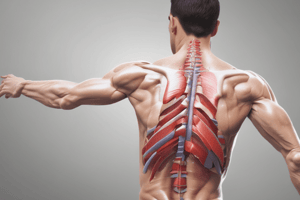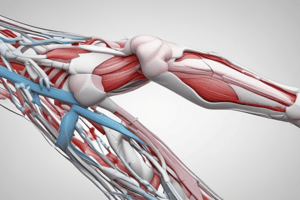Podcast
Questions and Answers
Total hip replacement is always the most appropriate option for patients with severe knee arthritis.
Total hip replacement is always the most appropriate option for patients with severe knee arthritis.
False (B)
Total Knee Arthroplasty is also known as knee replacement surgery.
Total Knee Arthroplasty is also known as knee replacement surgery.
True (A)
The knee joint is composed of the femur, tibia, and patella.
The knee joint is composed of the femur, tibia, and patella.
True (A)
Physiotherapy plays a critical role in the rehabilitation process after total knee arthroplasty.
Physiotherapy plays a critical role in the rehabilitation process after total knee arthroplasty.
Joint dislocation refers to the partial separation of two or more bones at an articulating joint.
Joint dislocation refers to the partial separation of two or more bones at an articulating joint.
Trauma, falls, sports injuries, and motor vehicle accidents are common causes of joint dislocations.
Trauma, falls, sports injuries, and motor vehicle accidents are common causes of joint dislocations.
Open reduction is a non-surgical technique involving the manual manipulation of the dislocated joint back into its normal position.
Open reduction is a non-surgical technique involving the manual manipulation of the dislocated joint back into its normal position.
True or false: Knee dislocations are most common in the posterior position?
True or false: Knee dislocations are most common in the posterior position?
True or false: Total hip replacement may involve minimally invasive and robotic-assisted surgeries?
True or false: Total hip replacement may involve minimally invasive and robotic-assisted surgeries?
True or false: Shoulder dislocations are often caused by dynamic forces?
True or false: Shoulder dislocations are often caused by dynamic forces?
Shoulder dislocations are most commonly anterior, accounting for 90% of cases?
Shoulder dislocations are most commonly anterior, accounting for 90% of cases?
Total hip replacement involves removing the pelvis and head of the thighbone?
Total hip replacement involves removing the pelvis and head of the thighbone?
Knee dislocations are most common in the anterior position?
Knee dislocations are most common in the anterior position?
Elbow dislocation is the most common large joint dislocation?
Elbow dislocation is the most common large joint dislocation?
Total hip replacement was developed in ancient Egypt with bronze and gold fingers?
Total hip replacement was developed in ancient Egypt with bronze and gold fingers?
Partial hip replacement (hemiarthroplasty) involves replacing the pelvis and head of the thighbone?
Partial hip replacement (hemiarthroplasty) involves replacing the pelvis and head of the thighbone?
Joint dislocation refers to the complete separation of two or more bones at an articulating joint.
Joint dislocation refers to the complete separation of two or more bones at an articulating joint.
X-rays, CT scans, or MRIs may be necessary to confirm the diagnosis of joint dislocation.
X-rays, CT scans, or MRIs may be necessary to confirm the diagnosis of joint dislocation.
Closed reduction is a surgical technique involving the manual manipulation of the dislocated joint back into its normal position.
Closed reduction is a surgical technique involving the manual manipulation of the dislocated joint back into its normal position.
The knee is a commonly dislocated joint.
The knee is a commonly dislocated joint.
Immobilization using splints, casts, or braces is necessary post-reduction to prevent re-dislocation and promote healing.
Immobilization using splints, casts, or braces is necessary post-reduction to prevent re-dislocation and promote healing.
Total hip replacement is always the most appropriate option for patients with severe knee arthritis.
Total hip replacement is always the most appropriate option for patients with severe knee arthritis.
Total Knee Arthroplasty is performed to relieve pain and restore function in patients with severe knee arthritis or joint damage.
Total Knee Arthroplasty is performed to relieve pain and restore function in patients with severe knee arthritis or joint damage.
Physiotherapy interventions in late post-operative care may include agility training and gradual return to normal activities.
Physiotherapy interventions in late post-operative care may include agility training and gradual return to normal activities.
Total Knee Arthroplasty involves placing metal implants on the ends of the thigh bone and shin bone, and inserting a spacer between them.
Total Knee Arthroplasty involves placing metal implants on the ends of the thigh bone and shin bone, and inserting a spacer between them.
The knee joint is composed of the femur, tibia, and patella.
The knee joint is composed of the femur, tibia, and patella.
Physiotherapy helps reduce pain and swelling, and improves the overall quality of life after total knee arthroplasty.
Physiotherapy helps reduce pain and swelling, and improves the overall quality of life after total knee arthroplasty.
Total knee arthroplasty is also known as knee replacement surgery.
Total knee arthroplasty is also known as knee replacement surgery.
Advancements in technology and surgical techniques are expected to drive the future of knee arthroplasty.
Advancements in technology and surgical techniques are expected to drive the future of knee arthroplasty.
Alternatives to total hip replacement, such as pain medications and weight loss, can provide the same level of long-term improvement as total hip replacement for all patients.
Alternatives to total hip replacement, such as pain medications and weight loss, can provide the same level of long-term improvement as total hip replacement for all patients.
Flashcards are hidden until you start studying
Study Notes
-
Physical Therapy: Essential for restoring joint function, preventing stiffness, and strengthening muscles after joint dislocation.
-
Pain Management: Analgesics and anti-inflammatory medications may be prescribed to manage pain and reduce inflammation.
-
Shoulder Dislocation: Most common joint dislocation, with 90% being anterior and 4-10% being posterior. Anterior dislocations are often caused by static forces, while posterior dislocations are from dynamic forces.
-
Hip Dislocation: Can be anterior or posterior with various reduction techniques. Anterior dislocations may require axial load in a flexed, adducted hip, while posterior dislocations require flexion, abduction, and external rotation.
-
Knee Dislocation: Most common in the anterior position due to hyperextension force to the anterior tibia, with valgus, varus, or rotational forces also possible.
-
Elbow Dislocation: Second most common large joint dislocation, can be simple or complex with potential injury to the radial head, coronoid, or all three forming the terrible triad.
-
Total Hip Replacement: A surgical procedure where a damaged hip joint is replaced with an artificial joint. Developed in the 1940s and 1960s, now includes minimally invasive and robotic-assisted surgeries.
-
History of Total Hip Replacement: Originated in ancient Egypt with bronze and gold fingers, modern design developed by Sir John Charnley in the 1940s and 1960s.
-
Types of Hip Replacement: Total hip replacement involves removing the pelvis and head of the thighbone, partial hip replacement (hemiarthroplasty) only replaces the femoral head.
-
Indications for Hip Replacement: Osteoarthritis, rheumatoid arthritis, injury/fracture, hip osteonecrosis.
-
Procedure of Total Hip Replacement: Incision, joint preparation, implantation, post-operative care.
-
Benefits of Total Hip Replacement: Pain relief, mobility, improved quality of life, longevity of prosthetic hip.
-
Risks and Complications of Total Hip Replacement: Infection, implant loosening, wear damage, blood clots, dislocation, potential need for revision surgery.
-
Physical Therapy: Essential for restoring joint function, preventing stiffness, and strengthening muscles after joint dislocation.
-
Pain Management: Analgesics and anti-inflammatory medications may be prescribed to manage pain and reduce inflammation.
-
Shoulder Dislocation: Most common joint dislocation, with 90% being anterior and 4-10% being posterior. Anterior dislocations are often caused by static forces, while posterior dislocations are from dynamic forces.
-
Hip Dislocation: Can be anterior or posterior with various reduction techniques. Anterior dislocations may require axial load in a flexed, adducted hip, while posterior dislocations require flexion, abduction, and external rotation.
-
Knee Dislocation: Most common in the anterior position due to hyperextension force to the anterior tibia, with valgus, varus, or rotational forces also possible.
-
Elbow Dislocation: Second most common large joint dislocation, can be simple or complex with potential injury to the radial head, coronoid, or all three forming the terrible triad.
-
Total Hip Replacement: A surgical procedure where a damaged hip joint is replaced with an artificial joint. Developed in the 1940s and 1960s, now includes minimally invasive and robotic-assisted surgeries.
-
History of Total Hip Replacement: Originated in ancient Egypt with bronze and gold fingers, modern design developed by Sir John Charnley in the 1940s and 1960s.
-
Types of Hip Replacement: Total hip replacement involves removing the pelvis and head of the thighbone, partial hip replacement (hemiarthroplasty) only replaces the femoral head.
-
Indications for Hip Replacement: Osteoarthritis, rheumatoid arthritis, injury/fracture, hip osteonecrosis.
-
Procedure of Total Hip Replacement: Incision, joint preparation, implantation, post-operative care.
-
Benefits of Total Hip Replacement: Pain relief, mobility, improved quality of life, longevity of prosthetic hip.
-
Risks and Complications of Total Hip Replacement: Infection, implant loosening, wear damage, blood clots, dislocation, potential need for revision surgery.
Studying That Suits You
Use AI to generate personalized quizzes and flashcards to suit your learning preferences.




